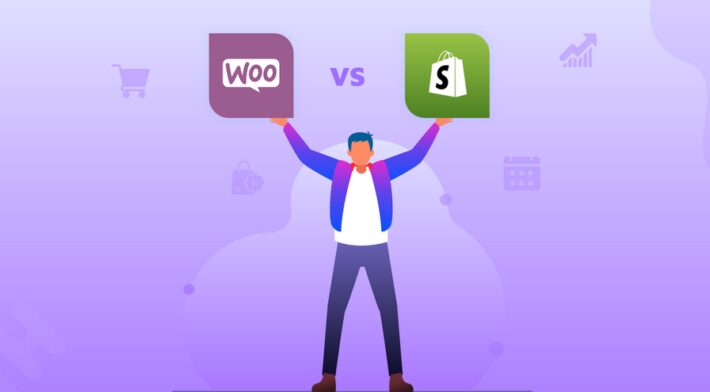
If you’re considering setting up an eCommerce store for your online business, then there are a few providers that can help you get up and running. Today though, we’re looking at the differences between Shopify and WooCommerce. These two platforms are world leaders in giving businesses the tools they need to build and run a successful online store, but each come with their own pros and cons. As someone who runs a business, deciding on which platform is best for you could be the deciding factor between the success or failure of your new online store, so we’re here to help you follow the platform that’s most suitable for your requirements.
Let’s take a deeper dive into the worlds of Shopify and wooCommerce.
A summary of Shopify and WooCommerce

Before we begin, let’s cover some of the basics of why these two platforms shine above other eCommerce rads on the market.
What does WooCommerce have on offer?
WooCommerce is a freely available plugin for use with the WordPress content management system, allowing you to turn your website into an online store. Custom extensions are available, allowing you to customize all aspects of your newly created store.
If you know your way around WordPress, this is a great option.
And how about Shopify?
Shopify, on the other hand, provides an all-in-one package that allows you to manage an entire store using a single platform to accept payments and keep an eye on your stock with ease. No hosting or technical know-how is required, although this option does come with a fee. Although a Shopify plan offers less customization than you’d find with a WooCommerce solution, there are several addons available in the form of apps, and you can read more about the apps that are available and how they can turn your Shopify store into an ECommerce powerhouse. By using apps, you can ensure the store is as user-friendly and attractive as possible.
What to consider to find the best platform

There’s no point in diving straight into creating an online store without knowing what you’ll be getting from the eCommerce platform you choose. The following factors will ensure your decision is the correct one when it comes to your comparison.
- Usability – are you tech-savvy or a web beginner?
- Pricing – Will it cost you a fee to run your online store?
- Customer Payment Methods – Can the platform support all major i.e. PayPal, credit cards.
- Customer support – is there someone to help when things go wrong?
Usability
The clear winner for ease of use off the bat is Shopify, mainly because going through the account creation process guides you every step of the way to building your store.
There is no hosting setup to worry about, although you will get the option to customize the store before hitting the publish button. Technical know-how is not required whatsoever.
The setup process for wooCommerce isn’t terribly complicated either, although there are several prerequisites you’ll need to cover before you get to the setup stage. You’ll need to install WordPress as the best eCommerce solution on your host, install and activate the plugin, etc. If you’re a complete newbie, then this might not be the greatest option for you.
Fortunately, if you decide to take this avenue, then many hosts offer a 1-click installation that installs WordPress and wooCommerce leaving you to log in and take care of the rest of the setup.

Pricing
Next up, you’ll want to ensure the platform you opt for is within your budget and won’t cost you the earth to run 9unless you have the cash to spare).
Although WooCommerce is open-source, it’ll immediately seem like the best and cheapest options, but once you begin adding those extensions we mentioned, the cost starts to add up quickly. Hosting a WordPress site with wooCommerce will cost you at least £5 per month, with a domain name at around £15 each year, plus your premium theme which could cost anywhere from £60 per year upwards. With all of the above fees, it’s not uncommon to end up spending more than you’d shell out for a Shopify plan which are:
Customer Payment Methods
Enough about getting the website up and running. The next thing to consider is how each platform will impact your customers, and how they perceive your business brand. The payment options that are available at Shopify consist of accepting PayPal Express Checkout from the moment you create your account.
Shopify will charge additional fees for transactions outside of the Shopify internal Payment system, so it’s best to use that to avoid those extra fees. The issue here is that Shopify Payments is only available to those in the UK, Canada, Australia, and the US with a handful of other countries at the time of writing. If your business resides outside of these countries, you will need to utilize a country-dependent payment gateway that comes bundled with various fees. If this sounds like your business, you may need to do a little digging to decide how this impacts you.
On the other hand, WooCommerce has extensions available to enable payment gateways. Using Stripe for credit cards and Paypal are fee-free, but using methods like Braintree, Amazon payments, or authorize.net will come with charges of a minimum of £80 each year. Although there are other payment options, these come at a cost too.
Customer Support
One of the last considerations we feel is essential is the support options available for both platforms. Phone, email, and live chat support is available for all Shopify users meaning you can connect with an agent whenever you need to.
WooCommerce is a little different in that there are no official support channels available. Instead, the company relies solely on the input from a community of users to assist you, that is, unless you shell out for a WooTheme. There are plenty of guides online to help with common issues, but that might take a little digging.
So, Shopify or WooCommerce?

The answer will vary here depending on your requirements, but for a small business looking to avoid the task of looking after a website, at a nominal cost, to get set up in minutes with a plethora of support, Shopify wins the crown here.
If customization of the look and feel of your store is important and you know your way around WordPress, then WooCommerce is the way to go.











